Yazd lies in a desert plain between two ranges of mountains, from which it receives its water supply.
A very old city, it used to lie on the southern branch of the Silk Road, and some of the hotels
in Yazd have been converted from old caravanserais.
Click on the little images to enlarge them.
| |
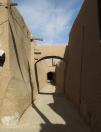 |
Narrow streets in the old part of Yazd |
 |
|
 |
Yazd is reputedly a religiously conservative city, though this was not obvious to us on a short visit.
However, we saw many house doors in the old part of the city which had separate door-knockers for men and women, as here.
(Men use the one on the left, women the one on the right.) The idea is that the two knockers make a different
sound, so that the occupant knows whether a man or a woman is at the door. |
 |
| |
| "Wind towers" are characteristic of Yazd. In the very hot summer, there is often a slight breeze at rooftop
level. The purpose of a wind tower is to catch the slight breeze and deflect some of it down into the house below. |
 |
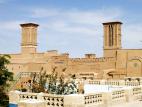 |
 |
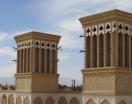 |
 |
| Amir Chakmaq square. Despite the minarets, the tall building isn't a mosque, merely a façade. The strange wooden structure on the right is a kind of float used in processions. It would be carried by several people. |
 |
What appears to be a geometrical pattern on the column is actually a kind of script. |
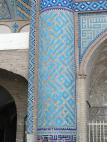 |
| Built in the fourteenth century, Kabir Jaame mosque has the tallest minarets of any mosque in Iran, but more noteworthy is the splendid detail of the glazed tile and mosaic decoration. |
 |
 |
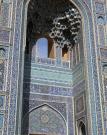 |
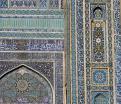 |
 |
| |
The largest community of Zoroastrians in Iran is in Yazd. One of the oldest monotheistic religions (possibly the oldest) in the world, Zoroastrianism was founded in Persia and became the official religion of the Achaemenian empire. Repressed in the years following the Arab conquest, many Zoroastrians fled to India, where they are known as Parsees. The most interesting visual reminder of their influence is an area just outside Yazd where their "Towers of Silence" can be seen.
The traditional Zoroastrian way of disposing of the bodies of the dead was to expose them to vultures; this is somewhat similar to the "celestial burial" or "sky burial" practised in Tibet. To prevent other scavengers from feeding on the bodies, they were placed in walled enclosures (usually on hilltops), so that only birds could get to them.
The "Towers of Silence" used by the Zoroastrians of Yazd are in the desert, and were originally some distance from the city, but because of urban expansion are now at the city's edge. The practice was therefore prohibited in 1970, and the Zoroastrian community was given land to use as a cemetery. |
 |
 |
The buildings at the bottom of the hill were used by the people who brought, accompanied, and prepared the bodies. |
 |
| The Zoroastrian temple in Yazd is modern (1934). It was built with the help of funds from the Parsee community in India. |
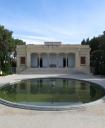 | |



















